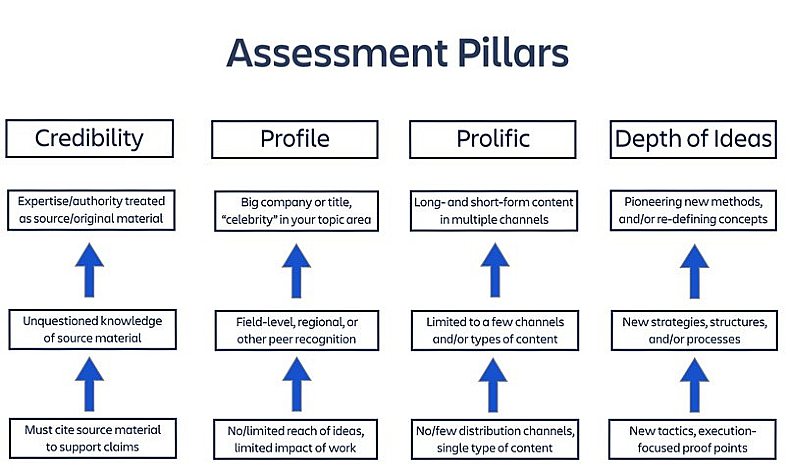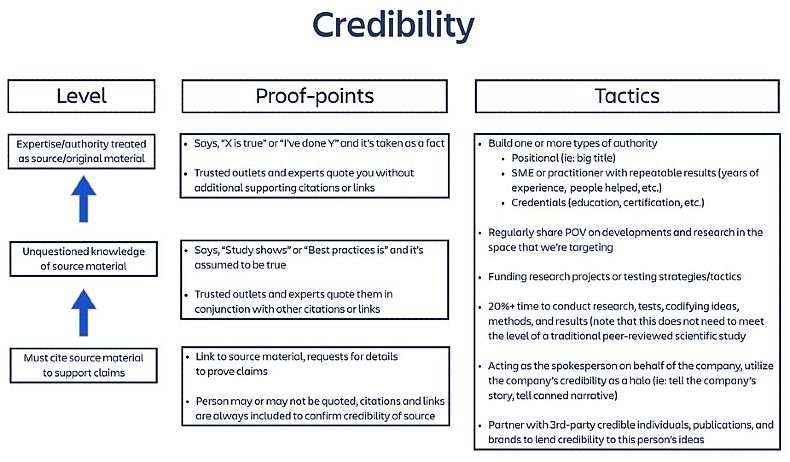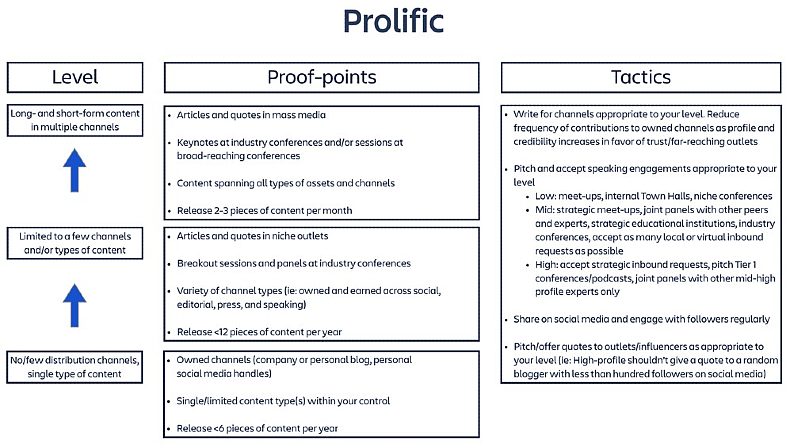Thought leadership is not a new topic. In fact, the term was coined by Joel Kurtzman back in 1994.
In the two-and-a-half decades since, we've seen the rise of YouTube experts, Instagram influencers, and the Kardashians.
But are all of those people thought leaders? Are any of them thought leaders?
To answer the same questions about yourself or the people you're trying to build into thought leaders on behalf of your company, you'll need a consistent framework to measure, assess, and track the progress of your efforts.
A Few Thoughts on Thought Leadership
There are differences between a thought leader and a celebrity, or a thought leader and a subject-matter expert. Being well-known does not make someone a thought leader, nor does being well-versed in a subject.
In a business context, focus on these criteria as you think about thought leadership:
- Thought leaders are knowledge workers. Don't focus on celebrities, musicians, sports stars, or entertainers; focus on people related directly or adjacently to your industry.
- Thought leaders need to have a thought. They need to be making improvements, executing strategies in novel ways, or otherwise iterating and introducing something new or original.
- Thought leaders are more than just good at their job. Plenty of people are smart and capable and produce great results for their career, team, and company, but thought leadership is about having influence outside of a single organization.
A Framework for Thought Leadership: Four Pillars
This thought leadership strategy framework consists of four pillars that work together: credibility, profile, being prolific, and depth of ideas.
You must work your way up each pillar to become a thought leader.

Credibility is about whether people perceive you as an authority in your discipline or industry. Do they trust what you say and view your advice and experience as accurate, or do they require you to quote more reputable sources?
Credibility can be positional—a title holder, a practitioner with repeatable results, or someone with extensive experience in the field, for example—or it can be developed through formal credentials, such as education and licenses. Credibility can be accelerated when paired with the halo of a strong brand or another prominent thought leader in the field.

Profile is about how many people know you; it also about the nature of those connections.
People with a low profile tend to have a small network of people whom they've met directly or worked with. People with a high profile are known to many others, including those whom they may have never met or had direct interactions with.

Being prolific is about both the frequency of your knowledge-sharing and the prestige of the outlets where you speak or publish. It's closely tied with having a strong profile, because as your profile improves so do your opportunities to share with bigger audiences.
Prolific people regularly post on social media; publish long-form and short-form content in the form of articles, e-books, and newsletters; speak at conferences and webinars; and give interviews on podcasts or to the media.
But we all start somewhere, and regular bylines on owned properties, such as a company blog, personal LinkedIn page, or self-hosted podcast, can help hone your message and skills, and also act as proof that you're capable when you want to work with more prestigious outlets.

Depth of ideas is about codifying your insights into processes and frameworks that teach others how to replicate your success.
Many people generate value for their team or their own bank account, but if they don't make their tactics and strategies available for others to learn and follow, they are not thought leaders.

So, how do the pillars work together?
To build credibility and a profile, you need to be prolific with writing, speaking, and engaging with your followers. But being prolific about mindless or useless topics doesn't build a thought leader, so you need to have tactical, strategic, and, in some cases, visionary ideas.
It's much easier to have profound ideas if you've already been in your field for years, or you've tackled a class of problems before, both of which also bolster your credibility.
A lot of companies try to use founders or C-suite executives as thought leaders because they tend to already have credibility due to their title. But if those people aren't prolific, they will struggle to build a profile. And a title alone will not open doors.
Getting Started on Your Thought Leadership Strategy
1. Start with a problem you've solved
What's a problem that you know backwards and forwards? What's the question you always seem to be answering for your colleagues? Start with that.
One silver lining of the rise in working from home is that more teams are writing documentation and hosting Zoom meetings, which you can then record, transcribe, and use the transcript as the basis for content. Capture the conversations as you're working through tough problems, and adapt relevant content for an external audience.
Now, if you're building a platform on behalf of a founder or executive, at some point that person has to get in a room with you and do the work. It's not enough for an exec to just give you a data sheet of features with a single line about value proposition and call it thought leadership. The goal of thought leadership is not to sell a product or service, and it's certainly not to trick people into buying something.
To create interesting content, you can break problems into three levels of depth: conceptual, strategic, and tactical.
- Conceptual content targets core ideas, such as how to think about the problem or how to find a solution.
- Strategic content addresses the processes and frameworks that people need to make those conceptual ideas a reality; it enables your audience to do their own research and come to a conclusion.
- Tactical content is the set of prescriptive, step-by-step instructions on how to implement regular activities and reach that conclusion.
Notice that none of those calls for a specific product feature or service offering. A product or service might make a problem easier to solve, but it won't help you gain credibility.
If you are working with founders or executives, dig into how they stumbled upon the problem they built their product to solve. What trends in the industry influenced their thinking? What changed to make then-current solutions obsolete?
That's the kind of interesting content you share with the world—not a data sheet of features.
2. Do a little each day
If you look at the most brilliant and influential thinkers in history, they were all prolific. They wrote or drew or spoke or calculated every single day.
Social media and blogging platforms are available to everyone, so you have the ability to share something every day. That could be amplifying other thought leaders in your field, sharing a quick observation about a problem or solution at work, or even giving a personal productivity tip.
The goal is to get in the habit of sharing frequently. It's much more difficult to be brilliant on demand than to cultivate a habit of observing, distilling, and sharing insights.
James Clear, author of Atomic Habits, used that tactic to turn his daily blog posts into a best-selling book, and Seth Godin uses daily microblogs to share marketing and business truths.
Markets change, people evolve, and problems morph. You can therefore talk about them for years on end. If you're feeling like you've run out of features to tout, it's time to step away from sales-focused content and move toward story-based content. You'll find that you have a lot more to say when you aren't confined to a CTA or whitepaper.
3. Connect, connect, connect
To be a leader, you have to have followers. To have followers, you must engage with people!
I worked with an executive to start building his thought leadership strategy. He's well-known and well-respected inside the company, and anyone who's dealt with him or heard him speak at a Town Hall immediately respects and trusts him. But he wasn't known outside of a small circle within his wider professional peer group.
We created a plan for him to start connecting and sharing posts on LinkedIn, and he's built a following of more than 2,000 people. His posts now get shares, likes, and comments from people outside his immediate employee or peer group.
When I speak at conferences, I always tell people to find me on LinkedIn or Twitter and reach out with any thoughts or questions about the session. I've had follow-up coffee chats, I've reviewed strategy documents based on the tactics I've shared, and I've amplified content for people I've met through speaking.
The goal is authenticity. It's not about reaching a quota to create reciprocity; it's about genuinely building a network. If you want to see an example of a master connector, just look at Ann Handley of MarketingProfs! She regularly likes and replies to tweets from me, even though I have little to offer to improve her reputation or reach. And it's not just online; she's warm and attentive in person as well!
4. Hone your personal brand
When I work with executives to build their thought leadership strategies, I always have a segment about their personal brand: What do they wear? How do they write? Do they curse in writing or speaking? Do they share about their spouses or kids?
In many cases, the executives say, "I'll do whatever you tell me. Just tell me what you want. I'm just here to make the company look good." Wrong. I'm not going to turn you into a company shill, I'm trying to facilitate your journey to building your own brand and sharing your own expertise.
One woman I worked with felt as if she had to take on the openness and irreverence of her business partner, but it was clear she was uncomfortable with doing that. She wrote with a more academic tone, dressed in more formal clothes, and wanted to project a more polished image.
It's less important to pick the "right" brand attributes than it is to pick authentic brand attributes, because your credibility is not just about your book knowledge; it's about whether you seem trustworthy. If you're wearing a costume, reciting a script, or putting on a show in some way, people won't believe you.
An easy way to start this exercise for yourself or an executive is to take a look at the biography that you provide to different outlets. Mine says, "Marketer, writer, and speaker by day. Singer, actor, and fitness fiend by night." That says something about me, and you immediately have a feel for who I am and how I might conduct a session.
I could just as easily have written, "Ashley Faus is a seasoned marketing professional, and works as the content strategy lead for software teams at collaboration software maker Atlassian." Different tone, right? One is not better or worse, and both are factually accurate, but they convey very different messages about how I want you to perceive me.
Start with several versions of your bio, both short and long. What accomplishments do you want front and center? What should you cut if you have a word restriction?
Writing your bio is a handy way to home in on the tone that will inform the rest of your long-form and short-form writing and speaking.
* * *
The norms of work are changing at an accelerated pace, and building a thought leadership strategy is more important than ever. It may seem daunting to add one more thing to an already stressful time, but we all have something unique to share, and we should.
More Resources on Thought Leadership Strategy
So Much of What You Knew About Thought Leadership Has Changed
Content Marketing and Thought Leadership: What's the Difference?




